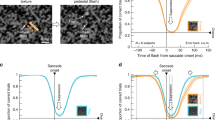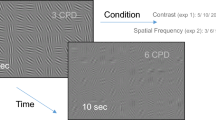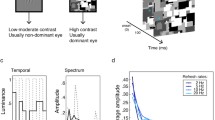Abstract
To determine whether saccadic suppression of image displacement uses information from luminance channels, we measured spatial displacement detection thresholds with equiluminant and nonequiluminant targets during saccades. We compared these saccadic thresholds with displacement thresholds measured during fixation by making ratios of saccadic thresholds to fixation thresholds. Ratios were lower in the equiluminant condition than in the nonequiluminant. This surprising result indicates that detection of equiluminant target displacements during saccades was better than detection of nonequiluminant targets, compared with the detection abilities during fixation. Thus, saccadic suppression of image displacement, which should increase displacement thresholds during saccades over fixation thresholds, was more effective with nonequiluminant targets. Because of target flicker, displacement thresholds were anisotropic in the nonequiluminant condition; thresholds were greater when target and eye moved in the same direction than when they moved in opposite directions, consistent with earlier results. These two effects (flicker-induced anisotropy and greater suppression in nonequiluminance) canceled when the eye moved opposite the displacement, yielding equal thresholds, and summed when eye and target moved in the same direction, yielding large threshold differences. We conclude that saccadic suppression of image displacement uses mechanisms sensitive to luminance contrast.
Similar content being viewed by others
References
Bridgeman, B. (1983). Mechanisms of space constancy. In Hein, A., & Jeannerod, M. (Eds.), Spatially oriented behavior. New York: Springer-Verlag.
Bridgeman, B., Hendry D., & Stark, L. (1975). Failure to detect displacement of the visual world during saccadic eye movements. Perception & Psychophysics, 25, 241–243.
Bridgeman, B., & Stark, L. (1991). Ocular proprioception and efference copy in registering visual direction. Vision Research, 31, 1903–1913.
Brooks, B. A., & Fuchs, A. F. (1975). Influence of stimulus parameters on visual sensitivity during saccadic eye movement. Vision Research, 15, 1389–1398.
Burr, D. C., Concetta Morrone, M., & Ross, J. (1994). Selective suppression of the magnocellular visual pathway during saccadic eye movements. Nature, 371, 511–513.
Cavanagh, P., Tyler, C. W., & Favreau, O. E. (1984). Perceived velocity of moving chromatic gratings. Journal of the Optical Society of America. A., 1, 893–899.
DeValois, K. K., & Switkes, E. S. (1983). Simultaneous masking interactions between chromatic and luminant gratings. Journal of the Optical Society of America, 73, 11–18.
Dodge, R. (1900). Visual Perception during eye movement. Psychological Review, 7, 454–465.
Dogde, R. (1905). The illusion of clear vision during eye movement. Psychological Bulletin, 2, 193–199.
Gauthier, G., Nommay, D., & Vercher, J.-L. (1990). The role of ocular muscle proprioception in visual localization of targets. Science, 249, 58–61.
Grüsser, O. -J. (1972). Metacontrast and the perception of the visual world. European Journal of Physiology, 32 (Suppl.), R98.
Grüsser, O. -J., Krizic, A. & Weiss, L. -R. (1987). After-image movement during saccades in the dark. Vision Research, 27, 215–226.
Holt, E. (1903). Eye-movement and central anesthesia. Psychological Monographs, 4, 3–45.
Holtzman, J. D., Sedgwick, H. A., & Festinger, L. (1978). Interaction of perceptually monitored and unmonitored efferent commands for smooth pursuit eye movements. Vision Research, 18, 1545–1555.
Ilg, U. J., & Hoffmann, K. -P. (1993). Motion perception during saccades. Vision Research, 33, 211–220.
Ishida, T., Shinoda, H., & Ikeda, M. (1992). Threshold displacement size for perceiving a stable stimulus across saccades: Effects of equiluminance. In Advances in color vision technical digest, 1992. Washington, D.C.: Optical Society of America, 140–142.
Latour, P. (1966). Visual threshold during eye movements. Vision Research, 2, 261–262.
Lennie, P., & D'Zmura, M. (1988). Mechanisms of color vision. CRC Critical Reviews in Neurobiology, 3, 333–400.
Livingstone, M. S., & Hubel, D. H. (1987). Psychophysical evidence for separate channels for the perception of form. color, movement, and depth. Journal of Neuroscience, 7, 3416–3468.
Livingstone, M. S., & Hubel, D. H. (1988). Segregation of form, color, movement, and depth: anatomy, physiology, and perception. Science, 240, 740–749.
Macknik, S. L., Fisher, B. D., & Bridgeman, B. (1991). Flicker distorts visual space constancy. Vision Research, 31, 2057–2064.
Macknik, S. L., Switkes, E. S., & Bridgeman, B. (1991). Saccadic suppression at Isoluminance. Investigative Opthalmology and Visual Science: Supplement, 32, 899.
Matin, E. (1974). Saccadic suppression: A review and an analysis. Psychological Bulletin, 81, 899–917.
Matin, E., Clymer, A., & Matin, L. (1972). Metacontrast and saccadic suppression. Science, 178, 179–182.
Pola, J. & Wyatt, H. H. (1989). The perception of target motion during smooth pursuit eye movements in the open-loop condition. Characteristics of retinal and extraretinal signals. Vision Research, 29, 471–483.
Ramachandran, V. S., & Gregory, R. L. (1978). Does colour provide an input to human motion perception? Nature, 275, 55–57.
Sperry, R. W. (1950). Neural basis of the optokinetic response produced by visual inversion. Journal of Comparative Psychology and Physiology, 43, 482–489.
Stark, L., Kong, R., Schwartz, S., Hendry, D., & Bridgeman, B. (1976). Saccadic suppression of image displacement. Vision Research, 16, 1185–1187.
Teuber, H. -L. (1960). Perception. In Field, J. & Magoun, H. W. (Eds.), Handbook of physiology Sect. 1: Neurophysiology, Vol. III Washington, DC: American Physiological Society, 1595–1668.
Tyrrell, R. A., & Owens, A. D. (1988). A rapid technique to assess the resting states of the eyes and other threshold phenomena: The Modified Binary Search (MOBS). Behavior Research Methods, Instruments, & Computers, 20, 137–141.
von Holst, E., & Mittelstaedt, H. (1950). Das Reafferenzprinzip. Wechselwirkungen zwischen Zentralnervensystem und Peripherie. Naturwissenschaften, 37, 464–476.
Yasui, S., & Young, L. R. (1975a). Eye movements during afterimage tracking under sinusoidal and random vestibular stimulation. In Lennerstrand, G., & Bach-y-Rita, P. (Eds.), Basic mechanisms of ocular motility and their clinical implications. New York: Pergamon Press.
Yasui, S., & Young, L. R. (1975b). Perceived visual motion as effective stimulus to pursuit eye movement system. Science, 190, 906–908.
Zuber, B., & Stark, L. (1966). Saccadic Suppression: Elevation of visual threshold associated with saccadic eye movements. Experimental Neurology, 16, 65–79.
Author information
Authors and Affiliations
Corresponding author
Rights and permissions
About this article
Cite this article
Bridgeman, B., Macknik, S.L. Saccadic suppression relies on luminance information. Psychol. Res 58, 163–168 (1995). https://doi.org/10.1007/BF00419631
Received:
Accepted:
Issue Date:
DOI: https://doi.org/10.1007/BF00419631




